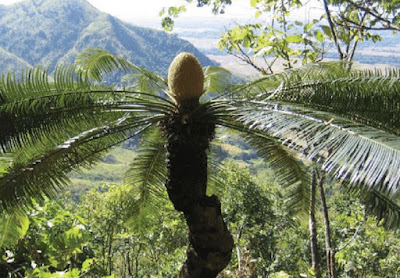|
|
 |
| Cycas pectinata – Fern Palm |
The Fern Palm, is a medium to large-sized cycad. It typically grows as a solitary trunked plant that may reach up to 10 meters (33 ft) tall in mature specimens. The trunk is cylindrical and covered with persistent leaf bases. Its leaves are pinnate (feather-like), dark green, and can grow up to 3 meters long, giving the plant a palm-like appearance.
The leaflets are narrow and arranged in a distinct comb-like pattern, which gives the species its name — “pectinata” meaning “comb-like.” New leaves often emerge with a bronze or reddish tint, gradually turning green as they mature.
Fern Palm is found in the subtropical and tropical forests of northeastern India, Bhutan, Nepal, Bangladesh, northern Myanmar, northern Thailand, Laos, and parts of southern China. It typically grows on slopes, rocky hillsides, or in open forest areas, often at elevations between 300 and 1,200 meters above sea level.
Like all cycads, Cycas pectinata is dioecious, meaning male and female reproductive organs occur on separate plants. Males produce cone-like structures called microstrobili, while females bear megasporophylls, which are modified leaves bearing ovules.
Pollination is usually facilitated by wind or insects. After fertilization, large seeds are produced, which may take several months to mature. Germination is slow, and seedlings grow very gradually, sometimes taking years to develop a recognizable trunk.
Cycads play an important role in forest ecosystems, including nitrogen fixation through symbiotic relationships with cyanobacteria in their roots. In some traditional cultures, cycads are used for ornamental purposes, religious ceremonies, and even food — though seeds must be carefully processed to remove toxins.
Due to its striking appearance and historical significance, Cycas pectinata is cultivated in tropical and subtropical gardens around the world. It prefers well-drained soil, partial shade, and protection from frost. However, care must be taken when growing cycads, as many species contain toxic compounds and should be handled with care, especially around pets and children.
Cycas pectinata is a remarkable species that connects the present-day flora with the prehistoric world. Its majestic form, resilience, and rarity make it a plant of both scientific interest and ornamental value. Preserving this species in its natural habitat and through sustainable cultivation is essential to maintaining the biodiversity of ancient plant lineages.
While Fern Palm is not currently classified as endangered, it faces threats from habitat destruction, deforestation, and illegal collection for ornamental and horticultural purposes. In many regions, wild populations are in decline. Conservation efforts include habitat protection, regulation of trade, and propagation in botanical gardens and nurseries.
 |
| Cycas pectinata – Fern Palm |
 |
| Cycas pectinata – Fern Palm Young Plant |
 |
| Cycas pectinata Young Plant |
 |
| Young Plant of Fern Palm |
 |
| Young Plant of Cycas pectinata – Fern Palm |
 |
| Cycas pectinata – Fern Palm Leaves |
 |
| Cycas pectinata Leaves |
 |
| Leaves of Cycas pectinata |
 |
| Cycas pectinata – Fern Palm Trunk |
 |
| Cycas pectinata – Fern Palm Male cone |
 |
| Fern Palm Male Cone |
 |
| Cycas pectinata Male Cone |
 |
| Cycas pectinata Megasporophyll |
 |
| Megasporophyll of Fern Palm |
 |
| Fern Palm Megasporophyll |
 |
| Matured Megasporophyll |
 |
| Cycas pectinata – Fern Palm Seed |
 |
| Cycas pectinata – Fern Palm |
 |
| Cycas pectinata – Fern Palm |
 |
| Cycas pectinata – Fern Palm |
No comments:
Post a Comment